 W
WAustralian Aboriginal artefacts include a variety of cultural artefacts used by Aboriginal Australians. Most Aboriginal artefacts were multi-purpose and could be used for a variety of different occupations. Spears, clubs, boomerangs and shields were used generally as weapons for hunting and in warfare. Watercraft technology artefacts in the form of dugout and bark canoes were used for transport and for fishing. Stone artefacts include cutting tools and grinding stones to hunt and make food. Coolamons and carriers such as dillybags, allowed Aboriginal peoples to carry water, food and cradle babies. Message sticks were used for communication, and ornamental artefacts for decorative and ceremonial purposes. Aboriginal children’s toys were used to both entertain and educate.
 W
WA blowgun is a simple ranged weapon consisting of a long narrow tube for shooting light projectiles such as darts. It operates by having the projectile placed inside the pipe and using the force created by forced exhalation ("blow") to pneumatically propel the projectile. The propulsive power is limited by the strength of the user's respiratory muscles and the vital capacity of their lungs.
 W
WA boomerang is a thrown tool, typically constructed as a flat airfoil, that is designed to spin about an axis perpendicular to the direction of its flight. A returning boomerang is designed to return to the thrower. It is well known as a weapon used by some Aboriginal Australian peoples for hunting.
 W
WA bulibuli or vunikau bulibuli is a fijian war club.
 W
WA Culacula is a paddle war club from Fiji.
 W
WThe fukiya (吹き矢) is the Japanese blowgun, as well as the term for the associated sport. It consists of a 1.2-metre-long tube, with darts approximately 20 centimetres (7.9 in) in length. Unlike modern Western blowguns, the fukiya has no mouthpiece: instead, a shooter must maintain a seal with the lips as he or she forcefully exhales. The darts used in the fukiya are called fukibari. Traditionally, fukibari were two inches in length.
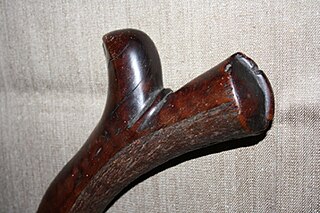 W
WThe Gata or Gata waka is a war club from Fiji.
 W
WA hand axe is a prehistoric stone tool with two faces that is the longest-used tool in human history, it is also a fine example of core tool. It is usually made from flint or chert. It is characteristic of the lower Acheulean and middle Palaeolithic (Mousterian) periods. Its technical name (biface) comes from the fact that the archetypical model is generally bifacial Lithic flake and almond-shaped (amygdaloidal). Hand axes tend to be symmetrical along their longitudinal axis and formed by pressure or percussion. The most common hand axes have a pointed end and rounded base, which gives them their characteristic shape, and both faces have been knapped to remove the natural cortex, at least partially. Hand axes are a type of the somewhat wider biface group of two-faced tools or weapons.
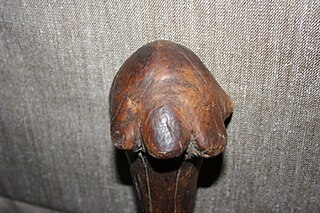 W
WA Kanak war club is a traditional weapon (mace) of the Kanak tribes of New Caledonia.
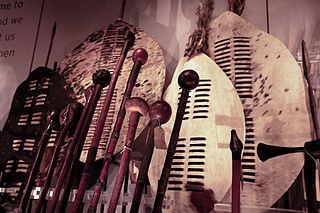 W
WA knobkerrie, also spelled knobkerry, knobkierie, and knopkierie (Afrikaans), is a form of club used mainly in Southern and Eastern Africa. Typically they have a large knob at one end and can be used for throwing at animals in hunting or for clubbing an enemy's head.
 W
WThe meteor hammer, often referred to simply as meteor, is an ancient Chinese weapon, consisting at its most basic level of two weights connected by a rope or chain. One of the flexible or "soft" weapons, it is referred to by many different names worldwide, dependent upon region, construction and intended use. Other names in use include dai chui, flying hammer, or dragon's fist. It belongs to the broader classes of flail and chain weapons.
 W
WIn North American archaeological terminology, a projectile point is an object that was hafted to weapon that was capable of being thrown or projected, such as a javelin, dart, or arrow. They are thus different from weapons presumed to have been kept in the hand, such as knives, spears, axes, hammers, and maces.
 W
WA qauata or qauaata is a parrying shield or war club of the San Cristobal Island in the Solomon Islands.
 W
WA rungu is a wooden throwing club or baton bearing special symbolism and significance in certain East African tribal cultures. It is especially associated with Maasai morans who have traditionally used it in warfare and for hunting. It is a commonly encountered tourist souvenir in that part of the world.
 W
WA Sali or Cali or Tebetebe is a war club from Fiji.
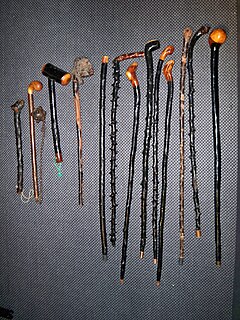 W
WA shillelagh is a wooden walking stick and club or cudgel, typically made from a stout knotty blackthorn stick with a large knob at the top. It is associated with Ireland and Irish folklore.
 W
WA sling is a projectile weapon typically used to throw a blunt projectile such as a stone, clay, or lead "sling-bullet". It is also known as the shepherd's sling. Someone who specializes in using slings is called a slinger. It was known in ancient China as the Piao Shih.
 W
WA slingshot is a small hand-powered projectile weapon. The classic form consists of a Y-shaped frame held in the non-dominant hand, with two natural-rubber strips or tubes attached to the upper two ends. The other ends of the strips lead back to a pocket that holds the projectile. The dominant hand grasps the pocket and draws it back to the desired extent to provide power for the projectile—up to a full span of the arm with sufficiently long bands.
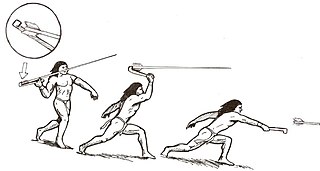 W
WA spear-thrower, spear-throwing lever or atlatl is a tool that uses leverage to achieve greater velocity in dart or javelin-throwing, and includes a bearing surface which allows the user to store energy during the throw.
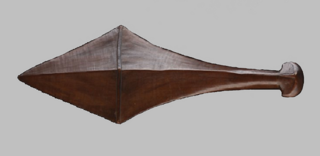 W
WThe supi is a war club of the Solomon Islands.
 W
WThe surujin or suruchin is one of the traditional weapons of Okinawan Kobudo. It comprises a 2–3 metre long rope with a weight tied to each end. Historically this weapon is very prevalent and can be found attached to a weapon or used separately. It is a weapon designed for warfare.
 W
WThe totokia is a type of club or battlehammer from Fiji.
 W
WThe U'u is a war club of the Marquesas Islands.
 W
WA waddy, nulla-nulla or boondi is an Aboriginal Australian hardwood club or hunting stick for use as a weapon or as a throwing stick for hunting animals. The first of these names comes from the Darug people of Port Jackson, Sydney. Boondi is the Wiradjuri word for this implement.
 W
WA woomera is a wooden Australian Aboriginal spear-throwing device. Similar to an atlatl, it serves as an extension of the human arm, enabling a spear to travel at a greater speed and force than possible with only the arm.